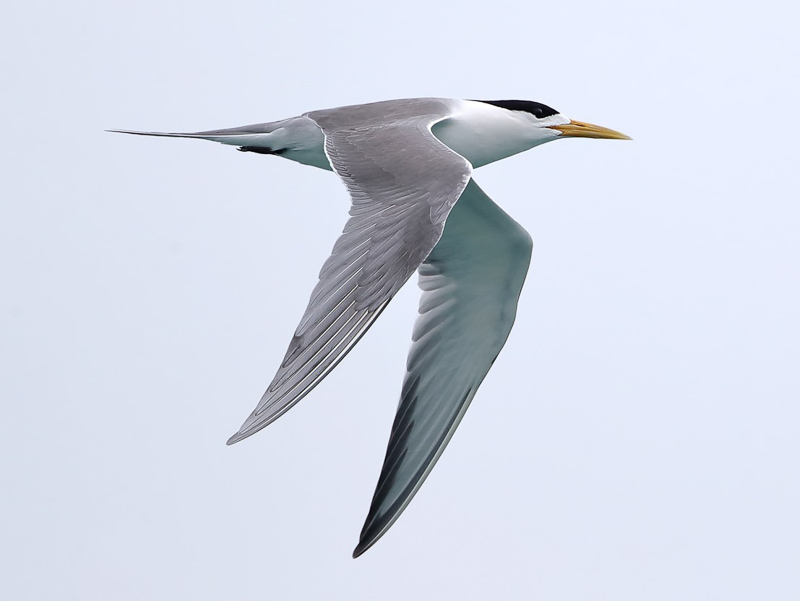Greater Crested Tern Thalasseus bergii 大鳳頭燕鷗
Category I. Passage migrant through coastal waters, more numerous in spring than autumn.
IDENTIFICATION

Mar. 2021, Michelle and Peter Wong. Adult.
45-53 cm. Large tern with white forehead all year, black legs and black cap and crest in breeding plumage. Mid-grey upperparts and yellow or greenish bill. Powerful flight.

Apr. 2021, Michelle and Peter Wong. Adult.
In flight the upperparts are plain, the forehead white and the tips to the underside of the primaries broad and black..

Sep. 2021, Michelle and Peter Wong. Adult and juvenile.
Juveniles have streaked forecrown, pale fringes to upperparts, tertials and greater coverts and pale legs.
VOCALISATIONS
There are no reports of vocalising birds in HK. The flight call is a ‘kirrow’ or ‘kirrik’, relatively low in pitch.
DISTRIBUTION & HABITAT PREFERENCE
Most records are from offshore waters to the south, with smaller numbers also recorded in eastern waters and, rarely, western waters. There is only one record away from there: an adult seen in the intertidal area of Deep Bay on 19 April 1993.
OCCURRENCE
The first record of Greater Crested Tern occurred on 9 June 1960 when two adults were seen near Tai Lam; this was not followed until 1984. It was only with the advent of more frequent sea-watches, initially during the passage of tropical storms and latterly from boats or ferries, that a clearer picture emerged of its true status.
As Figure 1 indicates, Greater Crested Tern is a passage migrant, more numerous in spring than autumn. The earliest record occurred on 21 March 2020, while main passage occurs during two periods: the first three weeks of April and the second week of May; this may indicate earlier passage of adults.
Passage ceases at the end of May and there are a small number of records in June and July. However, this reflects the pattern of observer activity, and it may be that more frequent observations would not only reveal more non-breeding birds occurring in this part of the South China Sea but also that significantly higher numbers pass through in early autumn. Autumn passage occurs in August and September, with the latest record occurring at Tai O on 3 October 1995 during the passage of a tropical storm.
The highest counts are of birds passing Po Toi in spring: 52 on 9 May 2013 and 33 on 21 April 2010. The highest autumn count is of 16 in southern waters on 10 September 2016.
A bird seen close to Po Toi on 17 September 2021 was ringed at Xiangshan, Zhejiang on 28 July 2018.
BEHAVIOUR, FORAGING & DIET
There are no reports of birds foraging in HK.
RANGE & SYSTEMATICS
Occurs coastally in southern Africa, Madagascar, Arabian Sea, Bay of Bengal, east and south China, southeast Asia, Greater and Lesser Sundas, Australasia and the tropical Pacific Ocean; northern populations are migratory (Gochfeld et al. 2020). In China breeds on islands in the Yellow Sea (Liu and Chen 2020). Long and short-distance migratory populations exist.
The taxon occurring in HK is T. b. cristatus, which breeds in the western Pacific from east China south to Australia. Three other taxa are recognised, in west Africa (bergii), western parts of the tropical Indian Ocean (thalassinus) and from the Red Sea to The Maldives, Sri Lanka and Myanmar (velox).
CONSERVATION STATUS
IUCN: Least Concern. Population trend stable.
Figure 1.

Gochfeld, M., J. Burger, G. M. Kirwan, D. A. Christie, and E. F. J. Garcia (2020). Great Crested Tern (Thalasseus bergii), version 1.0. In Birds of the World (J. del Hoyo, A. Elliott, J. Sargatal, D. A. Christie, and E. de Juana, Editors). Cornell Lab of Ornithology, Ithaca, NY, USA. https://doi.org/10.2173/bow.grcter1.01
Liu, Y. and Chen, Y.H. (eds) (2020). The CNG Field Guide to the Birds of China (in Chinese). Hunan Science and Technology Publication House, Changsha.

